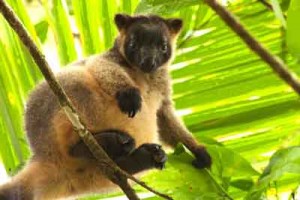These unique and beautiful Australian animals are only found in Far North Queensland but did you know that droughts are causing them to suffer blindness?
 Kangaroos can only be found in Australia but tree kangaroos are even more special. These beautiful creatures can only be found in the tropical rainforests of Australia’s far north-eastern corner.
Kangaroos can only be found in Australia but tree kangaroos are even more special. These beautiful creatures can only be found in the tropical rainforests of Australia’s far north-eastern corner.
They are often mistaken for possums or pademelon wallabies but if you look closely you will notice distinctive characteristics – dark faces and a yellowy-brown outline, small round ears and very long tails.
There are actually two species of tree kangaroos – the Lumholtz and the Bennett’s tree kangaroos.
And, unlike many Australian animals, tree kangaroos are not nocturnal so they are easier to see during the day.
[headline size=”small” align=”left”]tree roo rescue & conservation centre[/headline]
 We recently met up with Karen Coombes, who runs the Tree Roo Rescue and Conservation Centre in Malanda in the Cairns Tablelands.
We recently met up with Karen Coombes, who runs the Tree Roo Rescue and Conservation Centre in Malanda in the Cairns Tablelands.
Often affectionately referred to as the ‘crazy tree kangaroo lady’, Karen is actually the world’s leading expert on Lumholtz tree kangaroos. She completed her PhD on the ecology, biology and habitat of these animals and established the rescue centre.
Karen had worked as a wildlife carer for almost 26 years and also as a vet nurse so this seemed like a natural progression.
[headline size=”small” align=”left”]threats faced by tree kangaroos[/headline]
 Karen says the tree kangaroos are brought into her care for a variety of reasons.
Karen says the tree kangaroos are brought into her care for a variety of reasons.
The main threats they face are attacks from domestic and wild dogs, being hit by cars and the loss of their natural habitat.
Unfortunately many Lumholtz tree kangaroos also suffer from Dry Weather Syndrome, which causes blindness.
[headline size=”small” align=”left”]dry weather syndrome[/headline]
 Veterinary Eye Specialist Dr Tony Read treats the roos in Karen’s care and says that Dry Weather Syndrome occurs after a prolonged period of dry weather.
Veterinary Eye Specialist Dr Tony Read treats the roos in Karen’s care and says that Dry Weather Syndrome occurs after a prolonged period of dry weather.
It appears that the lack of moisture in the dehydrated leaves eaten by the kangaroos causes a build up of toxins, which affects their central nervous system and causes blindness. Dr Read believes this is a climate change issue.
When we visited the Rescue Centre nine out of the 10 tree kangaroos in Karen’s care were blind, so it is a significant issue for these animals.
The only non-blind roo is a three year-old female named Zoe who was hand-reared by Karen.
[headline size=”small” align=”left”]tree roo awareness week[/headline]
 Karen works closely with zoos and Parks and Wildlife to set up captive breeding programs and to educate people about Lumholtz tree kangaroos.
Karen works closely with zoos and Parks and Wildlife to set up captive breeding programs and to educate people about Lumholtz tree kangaroos.
As a part of this the Tree Roo Rescue & Conservation Centre also runs Tree Roo Awareness Week, an initiative to educate people about these unique animals.
Nature photos thanks to wildlife photographer Sandy Carroll. To see more of her beautiful wildlife shots follow Sandy C Photography on Facebook or check out her videos on Vimeo.
[headline size=”small” align=”left”]travel nq fast facts:[/headline]
- The Tree Roo Rescue Centre relies on grants and donations.
- If you would like to find out more about these animals go to www.treeroorescue.org.au. To make a donation go to their Facebook page.
- Tree kangaroos mainly eat rainforest leaves so they can be difficult to look after. Last year Karen received a Government grant to plant 1600 more trees to help feed them. They also enjoy sweet potatoes, corn, bananas and apples.



Trackbacks/Pingbacks